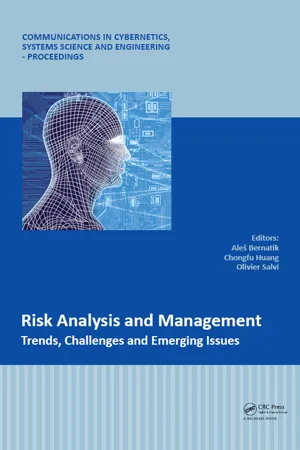
Risk Analysis and Management - Trends, Challenges and Emerging Issues
Proceedings of the 6th International Conference on Risk Analysis and Crisis Response (RACR 2017), June 5-9, 2017, Ostrava, Czech Republic
- 302 pages
- English
- ePUB (mobile friendly)
- Available on iOS & Android
Risk Analysis and Management - Trends, Challenges and Emerging Issues
Proceedings of the 6th International Conference on Risk Analysis and Crisis Response (RACR 2017), June 5-9, 2017, Ostrava, Czech Republic
About This Book
This book collects the papers presented at the 6th International Conference on Risk Analysis and Crisis Response (RACR-2017) held in Ostrava/Prague, Czech Republic, on June 5-9, 2017, organized by VSB-Technical University of Ostrava, Czech Republic. The overall theme of the sixth international conference on risk analysis and crisis response is Risk Analysis and Management – Trends, Challenges and Emerging Issues, highlighting science and technology to improve risk analysis capabilities and to optimize crisis response strategy.
This book contains primarily research articles of risk issues. Underlying topics include natural hazards and major (chemical) accidents prevention, disaster risk reduction and society resilience, information and communication technologies safety and cybersecurity, modern trends in crisis management, energy and resources security, critical infrastructure, nanotechnology safety and others. All topics include aspects of multidisciplinarity and complexity of safety in education and research. The book should be valuable to professors, engineers, officials, businessmen and graduate students in risk analysis and risk management.
About the book series
Communications in Cybernetics, Systems Science and Engineering - Proceedings (CCSSEP) is a cross-disciplinary book series devoted to theoretical and applied research contributions, that cater to a rapidly growing worldwide interest in a cybernetic and systemic methodology with an ever-increasing capacity to deal with new challenges in a way that traditional science cannot. The series aims to become a comprehensive reference work on and guide to developments within the field and strategies required for better implementation of advances, with a view to environmental protection and sustainable social and economic development. The CCSSE series targets all working in theoretical and applied fields of cybernetics, systems science and engineering, e.g. academics, researchers and consultants, computer and information scientists, development and systems engineers, mathematicians, management cyberneticists and systemists, medical scientists, and intelligent and manufacturing engineers in industry, as well as leading decision- and policy-makers.
Series editor: Jeffrey 'Yi-Lin' Forrest
Frequently asked questions
Information
Cell type | Advantages | Disadvantages |
Grid cell | Easy to operate, simple and efficient operation | The grid unit does not reflect the disaster mechanism. The correlation between grid cells and hydrology, geology, topography and other environmental factors is poor. |
Administrative zones | The use of administrative zones for risk zoning is more conducive to administrative management | The use of administrative zones to carry out risk zoning ignores the natural attributes of disasters |
River basin | Using the river basin as a unit for risk zoning can reflect the characteristics and laws of the geological environment | The spatial scale of risk zoning based on river basin is large, which cannot meet the spatial accuracy requirement of small—scale shallow landslide in South China. |
Slope cell | Theoperation process is complex, and requires a higher data accuracy using the slope as the smallest unit for risk division. | The slope cell can reflect the disaster mechanism of the landslide and can meet the precision requirements of the small landslide risk zoning. |
Table of contents
- Cover
- Half Title
- Title Page
- Copyright Page
- Table of Contents
- Preface
- Organisation
- Sponsor
- RACR
- ARAMIS heritage, 10 years after the end of the project
- Author index